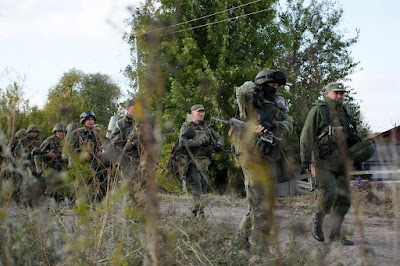However many casualties the Ukrainian army is enduring, analysts believe the Russians are suffering more - and are less able to replace them.
That is the consensus driving Ukraine strategy: that the Russians are throwing - literally - everything they have at the Donbas battle - and despite their advantages in materiel, they have been unable to make any significant headway. As long as Ukraine can hold on now, new supplies of weaponry and trained troops will turn the battle. JL
David Ignatius reports in the Washington Post:
Russian losses of soldiers and equipment have been staggering. The Pentagon estimates that the Russians have lost 2,600 armored vehicles, 30% of their inventory. The Russians have also fired 70% of their precision-guided munitions, and because of Western sanctions, Moscow (is) unable to resupply those munitions. Ukrainian counteroffensives have disrupted the Russians at the two points, Kharkiv near the Russian border and Kherson near the Black Sea. The Russians haven’t responded nimbly. “The Russians don’t have the ability for maneuver warfare they need for a massive breakthrough.” The Ukrainians aren’t winning right now, but they aren’t losing. And they have a lot more weapons arriving soon.Ukrainian officials have argued that they need more heavy weapons, fast, to hold the line against the Russian offensive in Luhansk and Donetsk provinces in the east. To take just one example, Mykhailo Podolyak, a senior Ukrainian official, tweeted this week that his country needs 300 multiple-launch rocket systems, or MLRS — nearly 30 times what’s on the way.
The example illustrates a weapons-supply problem that worries many American experts. Just four MLRS rocket launchers have actually been delivered, officials say, with eight more arriving soon. “Twelve is not enough. Not even close,” counters retired Lt. Gen. Ben Hodges, who commanded U.S. Army troops in Europe. “It seems like we keep pulling our punches, and all that does is prolong the war.”
Stephen Hadley, a former national security adviser to President George W. Bush, told me he agrees the administration needs to accelerate weapons deliveries. “We’re not in the ballpark of what we need to stop the Russians,” he contends. “It’s like we’re measuring in teaspoons rather than pouring in buckets-full.”
Administration officials are right that this isn’t a time for panic about Ukraine. But President Biden needs to demonstrate, in a way that gets attention in Kyiv and Moscow, that he is truly prepared to deliver on his promise to give Ukraine “the means to deter and defend itself against further aggression,” as he put it in his May 31 op-ed in the New York Times. He can underline that statement by providing Ukraine with more weapons, more quickly, as it battles a brutal Russian offensive.
Pentagon officials say that more weapons are coming, in future presidential drawdowns from U.S. supplies. But they caution that delivery and training take time. The first Ukrainian MLRS team is scheduled to complete training on Wednesday, and it will be deployed next week, according to officials briefed by the Pentagon. Another Ukrainian team will start training as soon as the first one finishes.
The Ukrainians also complain that they don’t have enough heavy artillery and are running out of ammunition for the tubes they do have. Pentagon officials say the situation is more complicated. The Ukrainians are indeed short of ammo for their old, Soviet-era artillery, which fires 152 mm shells. The United States has scoured the globe looking for shells to fit these tubes, and has prodded producers in former Warsaw Pact nations, such as Bulgaria and Romania, to restart production.
To provide Ukraine with reliable artillery, the Pentagon two months ago began shipping modern, American-made M777 howitzers, which fire 155 mm shells. The United States has delivered more than 100 of them, and the total from all Western suppliers is about 200 tubes — equivalent to the firepower of 10 artillery battalions. The Ukrainian artillery barrages have been so intense that several dozen of the M777 tubes have burned out and are being repaired.
Ammunition for the M777 howitzers appears adequate, officials briefed by the Pentagon say. The United States initially supplied 250,000 rounds, and at the current burn rate, the Ukrainians have a roughly 30- to 40-day supply. More is coming, with U.S. defense contractors working triple shifts, and the Pentagon expects to provide a steady 20- to 30-day stockpile for Ukraine going forward.
Meanwhile, Russian losses of soldiers and equipment have been staggering. The Pentagon estimates that the Russians have lost 2,600 armored vehicles, or about 30 percent of their inventory. That includes about 1,000 tanks and 1,600 armored personnel carriers. The Russians have also fired nearly 70 percent of their precision-guided munitions, and because of Western sanctions, Moscow may be unable to resupply those critical munitions.
From the first days of the war, Pentagon officials have feared that the Ukrainians could be encircled in the east in a classic “double encirclement” pincer movement. But Ukrainian counteroffensives have disrupted the Russians at the two points of the pincer, Kharkiv near the Russian border and Kherson near the Black Sea. The Russians haven’t responded nimbly.
“The Russians don’t have the ability for the maneuver warfare they would need for a massive breakthrough,” Hodges told me Tuesday. He argues that Russian performance in this war shows they lack the command-and-control, logistics and integrated air-land tactics for such a complex assault.
The crucial variable in this long, brutal war may be “strategic patience,” in the words of retired Australian Army Maj. Gen. Mick Ryan. The Ukrainians aren’t winning right now, but they aren’t losing, either. And they should have a lot more weapons arriving soon.



















0 comments:
Post a Comment